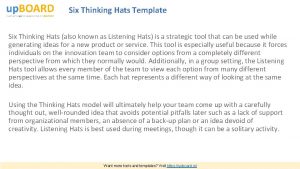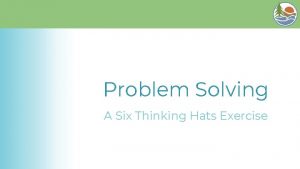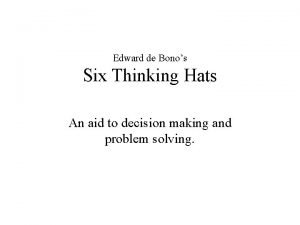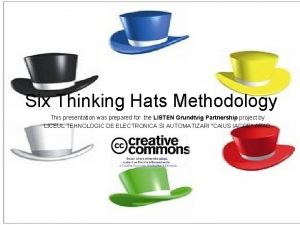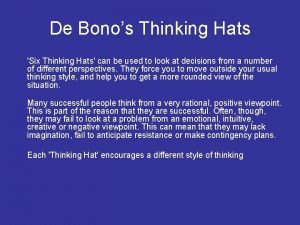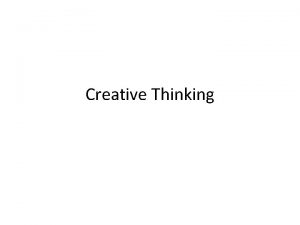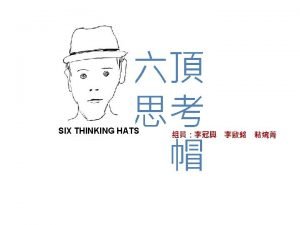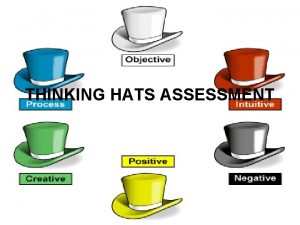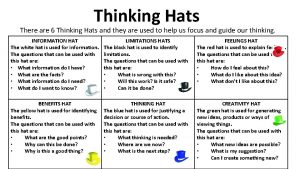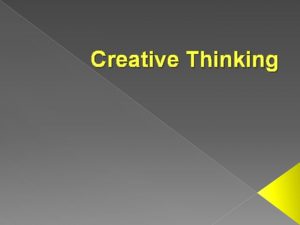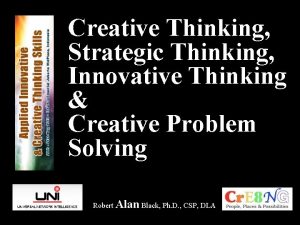THE 6 THINKING HATS LEADERSHIP SKILLS DEVELOPMENT CREATIVE














- Slides: 14

THE 6 THINKING HATS LEADERSHIP SKILLS DEVELOPMENT CREATIVE THINKING/PROBLEM SOLVING/ DECISION MAKING

WHITE HAT INFORMATION AVAILABLE & NEEDED § Stick to the facts and figures. § What information is available? § What information would we like to have? § What information do we need? § What information is missing? § Include both sided of disputed information.

RED HAT (EMOTIONS) • Refers to your feelings and emotions. • Take no more than 20 to 30 seconds • Share intuition, feelings, and emotions. • No explanation is needed!

BLACK HAT CAUTION, DIFFICULTIES, AND PROBLEMS • What can go wrong? • What could be the possible problems? • What could some of the difficulties be? • What are points for caution? • Make statements • Stay Negative

YELLOW HAT WHAT ARE THE POSITIVES? • What are the benefits? positives? values? savings? • Is there a competitive advantage? • Is there potential value? • Is there a concept in this idea that • looks attractive?

GREEN HAT CONSCIOUS CREATIVE EFFORT. • Are there other ways to do this? • What else could we do here? • What are the possibilities? • How else might we carry through this concept? • What will overcome our difficulties?

BLUE HAT MANAGING THE THINKING PROCESS • Sets the timing. • Decides on the next step. • Keeps everyone on the focus. • Handles requests. • Keeps the discipline when using the hats. • Handles the summary and conclusions. • Asks for decisions.

HOW TO USE SIX THINKING HATS? 2 WAYS: INCIDENTAL AND SYSTEMATICAL Incidental • Occurs during traditional argument or discussion – as break • One hat used at time to emphasize a certain way of thinking or switch to a different style. • Utilizing the hat this way can for example serve as a time-out which helps to clear the thinking.

ANOTHER WAY…. . Systematical • Decide on a topic you want to think about. • Determine a sequence for using the hats: your thinking agenda. • Then use the different hats in turn. • Useful when: • The thinkers have different opinions and dig in their heels leading to a dispute.

HOW MUCH TIME DO YOU SPEND PER HAT? • 90 seconds per hat can produce an impressive amount of output. • timing also depends on the number of people participating. • in general 3 to 4 minutes per hat suffices - as a group!

RULES OF THUMB FOR TIMING : • Allow limitless time for white hat when much information needs to be digested. But keep the thinking focused on subject! • Don't limit black hat thinking as long as new viewpoints are brought forward. Breaking off prematurely will always result in strong resistance. • For the same reasons also don't limit yellow hat thinking. • Be flexible with green hat thinking: switch to a different hat once the flow of ideas has stopped. You can always come back to the green hat later on. Only when using specific creative thinking methods allow for enough time to utilize them. • Restrict red hat thinking to 30 seconds to prevent people from wanting to explain or justify their feelings. Only allow more time when intuition and feelings form a major part of our subject. (For instance when acceptability of a new idea is an issue. ) • Always limit the thinking session for each hat at beginning. If it turns out to be appropriate, allow for extra time. • The timing is the task of the facilitator wearing the blue hat.

MEETINGS - MORE THAN 2 PEOPLE • Both the incidental as the systematical application of the hats is useful during meetings. • Important is that all participants are always wearing the same hat! • The facilitator usually has the blue hat on and structures the dialogue. • But everyone can make blue hat suggestions.

CONVERSATIONS - TWO PEOPLE • The most common way to use the hats during a conversation between two people, is incidental. • Use the hats to guide thinking and to ask for a different point of viewing the topic.

INDIVIDUAL § Though the hats were originally 'designed' for interpersonal use, they can be used in individual situations as well. § They structure your thoughts and prevent people from forgetting certain ways of thinking. It does take discipline!
 Perbedaan critical thinking dan creative thinking
Perbedaan critical thinking dan creative thinking The 7 hats of thinking
The 7 hats of thinking De bono 6 hats thinking template
De bono 6 hats thinking template Six hats
Six hats Blue hat means
Blue hat means 8 thinking hats
8 thinking hats Black hat six thinking hats
Black hat six thinking hats De bonos thinking hats
De bonos thinking hats Furman hats
Furman hats Video six thinking hats
Video six thinking hats 6 thinking hats presentation
6 thinking hats presentation Debonos thinking hats
Debonos thinking hats Yellow hat activity
Yellow hat activity De bonos thinking hats
De bonos thinking hats Six hats exercise
Six hats exercise


